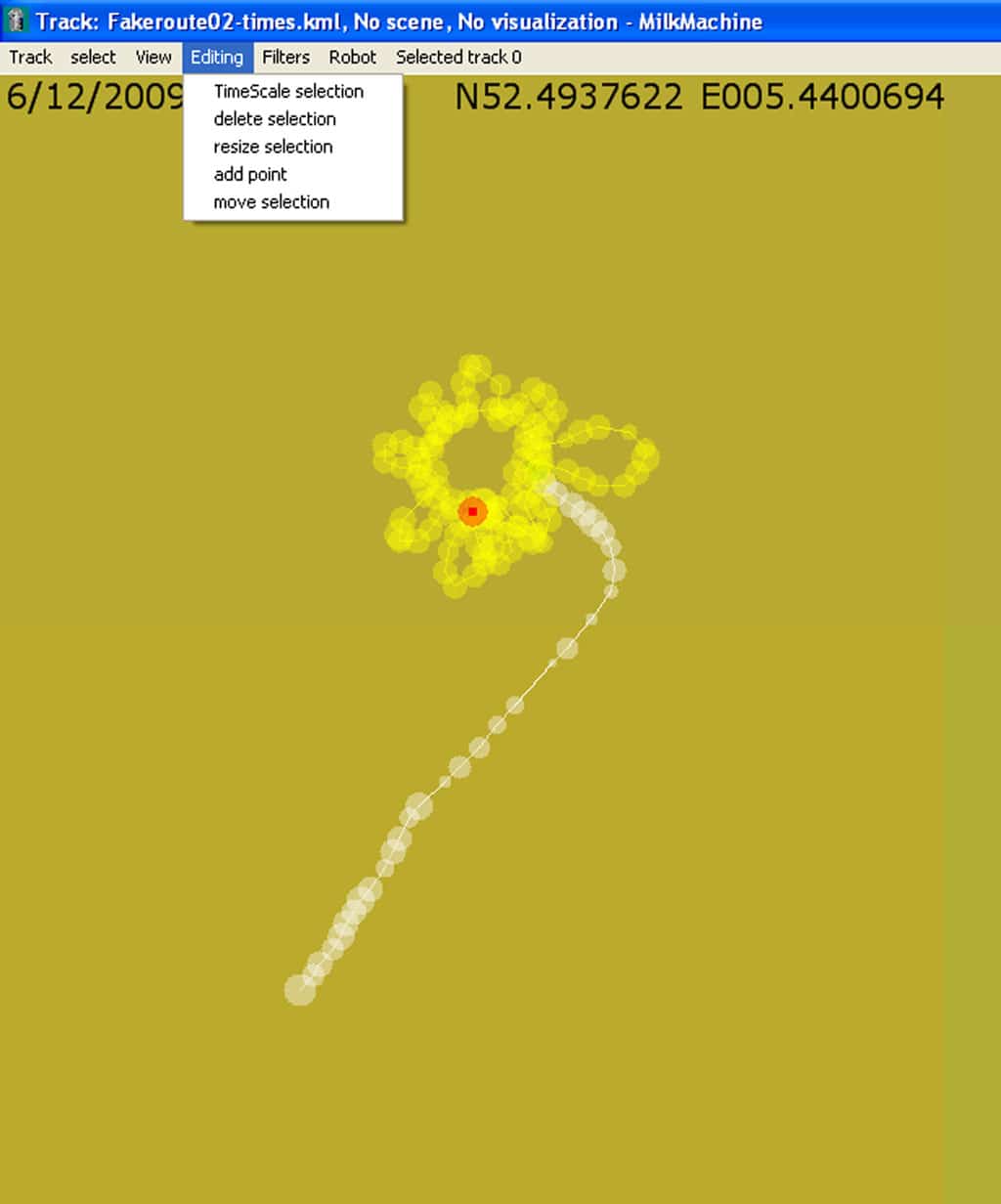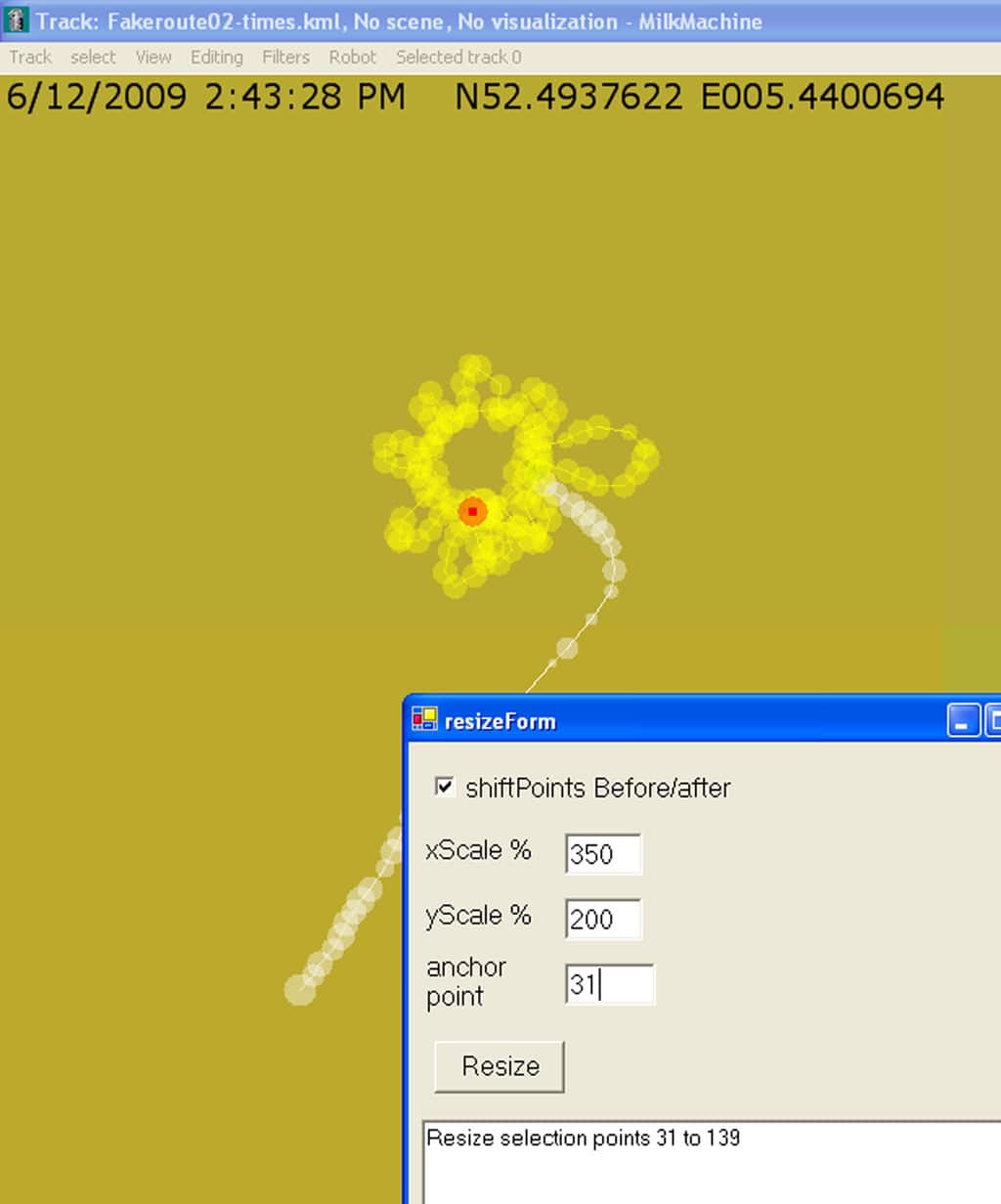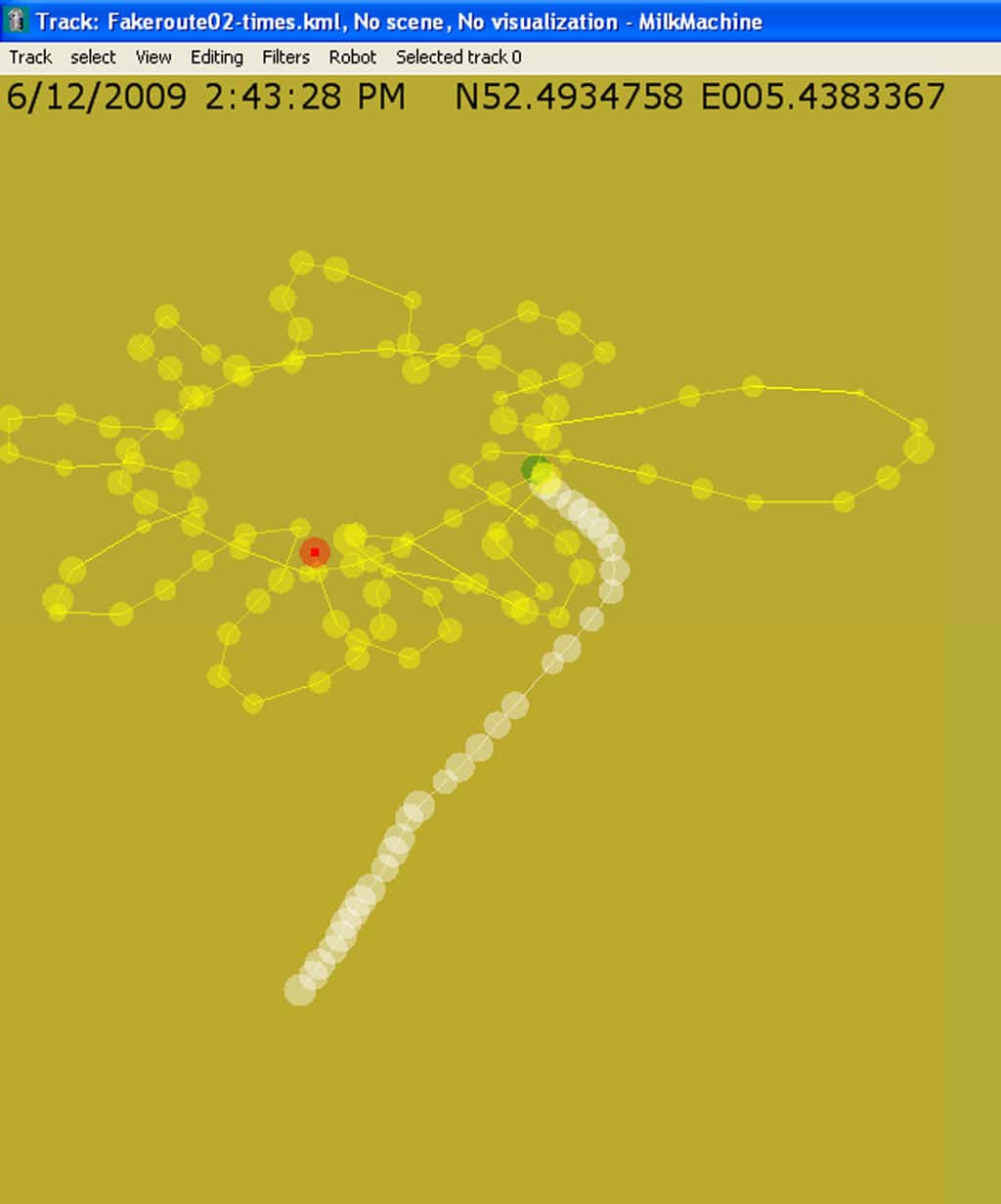An imagined software for GPS-data editing
This text is an abstract of an article presented at ISEA 2009 in Ireland. The full version can be downloaded at the end of the abstract.
August 29 2009: presentation of ElasticMapping concept at ISEA
ElasticMapping: Implications of
a GPS drawing robot in times of locative media
In my paper I will discuss what it means when GPS-tracks become elastic, open for flexible plotting, radical editing even. In each of my subsequent projects the visualizations evolve from more abstract data visualization (AmsterdamREALTIME) to more subjective, flexible and even abstract representations.
I also designed settings where interaction between the data, participants and audience played an increasing role (MILK project, SouvenirZeeland). During this process questions about the value of GPS data as realistic representations of movements, their potential as a storytelling tool, connections to local and global experiences of space, and experiences of and representations of time became more and more important.
In my paper I will especially focus on the implications of GPS data visualization in my latest and still evolving project NomadicMILK. In this project two dairy economies in Nigeria are being followed and portrayed by means of GPS data. Both Nigerian nomadic cow herders and truck drivers depend on mobility for economic survival. In the NomadicMILK project their mobility patterns are visualized with a specially developed tool: a GPS drawing robot that is able to present GPS tracks in outdoors situations, independent of power supply or indoor shelter. The robot draws GPS tracks directly on the ground by replotting them to a chosen spatio-temporal scale. It is equipped with a bottle filled with sand, a hole in the lid makes it function like a drawing hourglass. The sand drawings are used both to present the tracks to the participants, as well as to the audience in exhibition situations later. This way the robot functions as a performative tool, making the GPS tracks tangible and physically present.
This approach brought about new needs of drawing. The representation of both time and space had to be compressed, scaled, and deformed in order to make the robot draw a sand line that is a representation to which the participants and audiences can relate in a direct manner. Moreover, the vastly different spatial and temporal scales of the two dairy economies had to be combined into one intersecting drawing.
During this process I found myself building a basic editing tool for GPS data. The manipulated tracks raise questions in themselves: it turns out to be something in between drawn routes from memory and hardcore GPS route registration. To my surprise the manipulated tracks became even more “real” in the experience of the participants …….if being recognizable as belonging to the self is a criterion for realism…. For the presentation to the audience, who did not have a direct personal relation to the tracks, another layer of editing needed to be added even to communicate the realism of the tracks. This seemingly contradictory approach between elastically manipulating data and aiming for realism raises questions for future artistic and theoretical developments in mapping and locative media projects.
Esther Polak, July 2009
Full text version of ElasticMapping 2009
Related:
August 18-26: Residence at SkulpturePark Berlin
Series of small experiments on existing software and PolakVanBekkum’s Milkmachine software to refine ideas on ElasticMapping.
See for another use of ElasticMapping: NomadicShopping
In my paper I will discuss what it means when GPS-tracks become elastic, open for flexible plotting, radical editing even. In each of my subsequent projects the visualizations evolve from more abstract data visualization (AmsterdamREALTIME) to more subjective, flexible and even abstract representations.
I also designed settings where interaction between the data, participants and audience played an increasing role (MILK project, SouvenirZeeland). During this process questions about the value of GPS data as realistic representations of movements, their potential as a storytelling tool, connections to local and global experiences of space, and experiences of and representations of time became more and more important.
In my paper I will especially focus on the implications of GPS data visualization in my latest and still evolving project NomadicMILK. In this project two dairy economies in Nigeria are being followed and portrayed by means of GPS data. Both Nigerian nomadic cow herders and truck drivers depend on mobility for economic survival. In the NomadicMILK project their mobility patterns are visualized with a specially developed tool: a GPS drawing robot that is able to present GPS tracks in outdoors situations, independent of power supply or indoor shelter. The robot draws GPS tracks directly on the ground by replotting them to a chosen spatio-temporal scale. It is equipped with a bottle filled with sand, a hole in the lid makes it function like a drawing hourglass. The sand drawings are used both to present the tracks to the participants, as well as to the audience in exhibition situations later. This way the robot functions as a performative tool, making the GPS tracks tangible and physically present.
This approach brought about new needs of drawing. The representation of both time and space had to be compressed, scaled, and deformed in order to make the robot draw a sand line that is a representation to which the participants and audiences can relate in a direct manner. Moreover, the vastly different spatial and temporal scales of the two dairy economies had to be combined into one intersecting drawing.
During this process I found myself building a basic editing tool for GPS data. The manipulated tracks raise questions in themselves: it turns out to be something in between drawn routes from memory and hardcore GPS route registration. To my surprise the manipulated tracks became even more “real” in the experience of the participants …….if being recognizable as belonging to the self is a criterion for realism…. For the presentation to the audience, who did not have a direct personal relation to the tracks, another layer of editing needed to be added even to communicate the realism of the tracks. This seemingly contradictory approach between elastically manipulating data and aiming for realism raises questions for future artistic and theoretical developments in mapping and locative media projects.
Esther Polak, July 2009
Full text version of ElasticMapping 2009
Related:
August 18-26: Residence at SkulpturePark Berlin
Series of small experiments on existing software and Polakvanbekkum’s Milkmachine software to refine ideas on ElasticMapping


